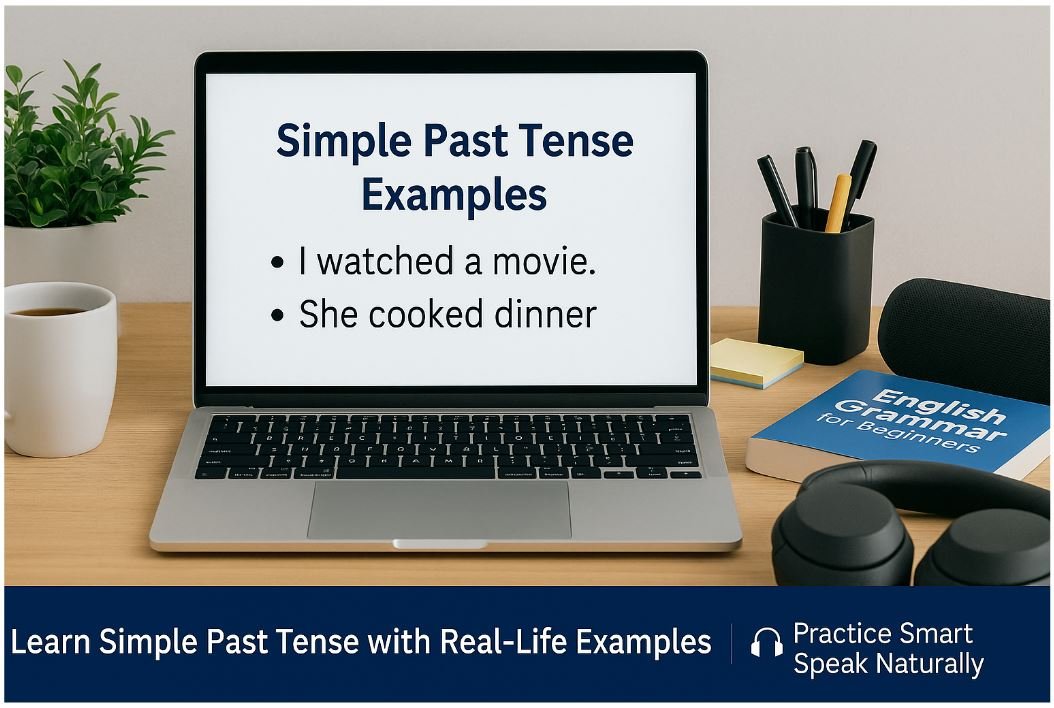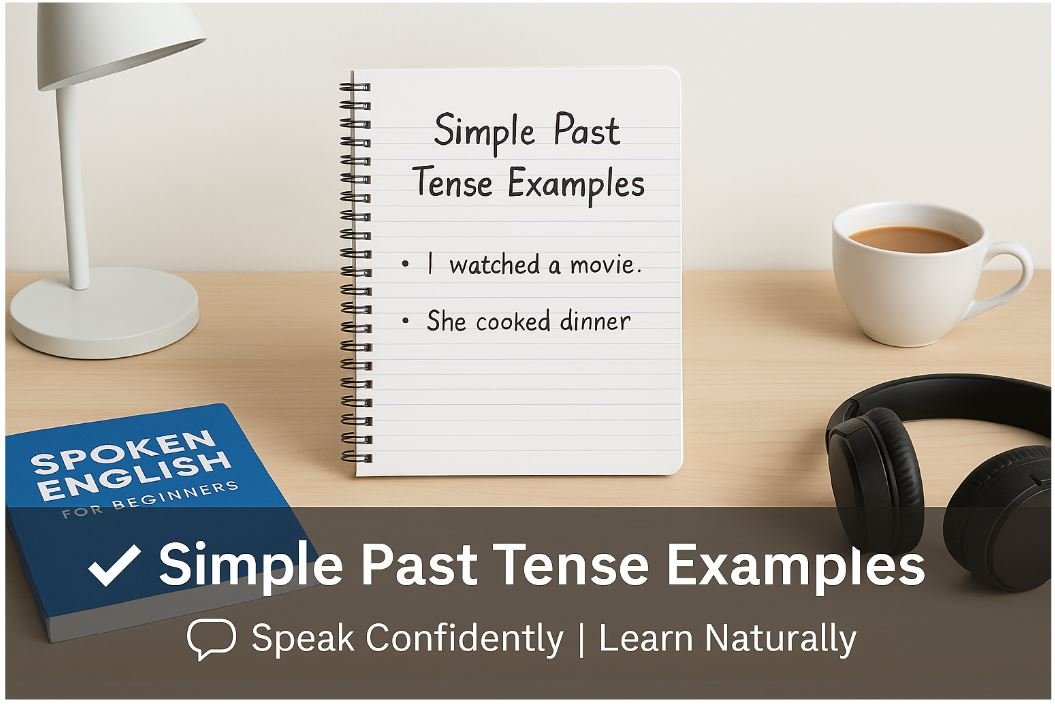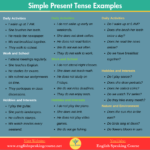Table of Contents
ToggleIntroduction
Have you ever wanted to talk about something you did yesterday, last week, or even last year—in English? That’s exactly what the Simple Past Tense helps you do. It’s one of the most common and useful tenses in everyday conversations, and the best part? It’s actually very easy to learn!
We use the simple past tense to talk about finished actions—things that already happened. For example:
- “I watched a movie last night.”
- “She cooked biryani yesterday.”
- “We visited Kolkata two days ago.”
These are simple past tense examples you’ll use often while talking with friends, sharing stories, or even during interviews. If you want to sound more natural and confident when speaking English, this is a great place to start.
👉 Quick Tip: Want to make your home study time more comfortable? Try using a comfortable study chair or a Spoken English practice book for beginners. These small things can really boost your focus and motivation while learning.
So don’t stress. In this post, we’ll break everything down step-by-step, using easy explanations and real-life simple past tense examples. Let’s begin your journey into the past—through the Simple Past Tense!
What is the Simple Past Tense?
Let’s keep it simple. The Simple Past Tense is used to talk about things that already happened in the past. These actions are complete—they started and finished before now.
We use it when we want to talk about:
- Something we did yesterday
- Something that happened last night, last week, or a long time ago
- Any finished action or event in the past
🔹 Easy Definition:
Simple Past Tense = Subject + Past form of verb
It tells us what someone did in the past.
🟢 When Do We Use It?
We use the simple past tense to:
- Tell stories or share memories
- Talk about our day
- Give information about what happened before
- Explain past habits or routines
Basically, anytime you say something that already happened, you’re using the simple past!
📝 Real-Life Examples:
Here are a few simple examples to help you understand:
- ✅ “I went to school yesterday.”
(The action – going to school – is complete.) - ✅ “She cooked dinner last night.”
(Cooking is done.) - ✅ “They watched a movie on Sunday.”
(The movie is over.) - ✅ “We played cricket last weekend.”
(Game is finished.)
You’ll notice that the verb (the action word) changes in the past. “Go” becomes “went,” “cook” becomes “cooked,” and so on. Don’t worry, we’ll talk more about regular and irregular verbs soon.
👉 Bonus Tip: Want to listen to past tense conversations easily? Try using a Bluetooth speaker or smart speaker like Alexa to play English audio lessons. Hearing real examples can help you learn faster!
Now that you know what the simple past tense is, let’s break down how to make sentences using it — both positive, negative, and questions.
Structure of Simple Past Tense (Affirmative / Negative / Question)
Now that you know what the simple past tense is, let’s look at how to make sentences using it. Don’t worry—it’s really easy once you get the pattern.
We’ll break it into three parts:
- Affirmative (positive sentences)
- Negative (saying something didn’t happen)
- Questions (asking something)
🟢 a) Affirmative Sentences (Positive)
This is the most basic structure.
👉 Structure:
Subject + past form of verb
🔸 Examples:
- “I visited my grandmother.”
- “He watched TV.”
- “They played football.”
Just remember: the verb changes to past form. So, “play” becomes “played,” “go” becomes “went,” “cook” becomes “cooked.”
🪄 Tip for learners: If you’re struggling to remember past forms of verbs, keeping a verb list book near your study table helps.
🔴 b) Negative Sentences (Something did NOT happen)
To say something didn’t happen, we use “did not” (or “didn’t”) and go back to the base form of the verb. Don’t use the past form here.
👉 Structure:
Subject + did not (didn’t) + base verb
🔸 Examples:
- “I didn’t go to school.”
- “She didn’t cook dinner.”
- “They didn’t play football.”
⚠️ Important: Never say “didn’t went” or “didn’t cooked.” That’s incorrect. After “didn’t,” always use the base form: go, cook, play, eat, etc.
❓ c) Question Sentences
To ask questions in the past, we begin with “Did,” followed by the subject and the base verb.
👉 Structure:
Did + subject + base verb?
🔸 Examples:
- “Did you visit your grandma?”
- “Did he watch the match?”
- “Did they play football?”
This is how we ask if something happened in the past.
🗣️ Practice Tip: You can practice speaking these aloud using a microphone, headphones, or even a smart speaker like Alexa. Try saying both positive and negative forms, and then ask yourself questions!
For example:
- “I watched a movie.”
- “I didn’t watch a movie.”
- “Did I watch a movie?”
You’ll be amazed how quickly you improve with a little daily speaking practice.

30+ Simple Past Tense Examples (Real Life)
Let’s look at some real-life examples of simple past tense that you can use in everyday English. These are short, easy sentences that talk about actions already completed. Try to read them aloud or write them down—it’s a great way to practice!
To make it easier, we’ll break them into small categories.
👨👩👧 Personal Life
These are things you might say when talking about your day, family, or free time.
- I called my friend last night.
- She washed her clothes yesterday.
- He cleaned his room in the morning.
- We listened to music together.
- They watched a comedy show.
- I slept late on Sunday.
- My sister cried after watching the movie.
🎒 School / Work
Useful for students, job seekers, or anyone describing what they did at school or work.
- I finished my homework.
- She wrote an email to her teacher.
- They submitted the project.
- We attended a meeting.
- He missed the class.
- I read a chapter from the English book.
- The boss called me yesterday.
✈️ Travel
Perfect for talking about trips or vacations—something people love to share in conversation.
- I went to Darjeeling last year.
- We took a train to Delhi.
- She visited her uncle in Mumbai.
- They stayed at a nice hotel.
- He forgot his passport.
- I missed the bus.
- We explored a beautiful temple.
🍛 Food / Cooking
Everyone talks about food! These examples are easy and fun to use.
- I cooked chicken curry last night.
- She made tea in the morning.
- We ate biryani on Sunday.
- He bought vegetables from the market.
- They ordered pizza.
- I drank a glass of milk.
- My mom fried some pakoras.
📝 Bonus Speaking Tip:
Try saying one sentence from each category every day. Speak in front of a mirror or record yourself using your phone or a small microphone. It’s a fun and easy way to build confidence!
Common Regular & Irregular Verbs List
To use the simple past tense correctly, you need to know how verbs change. Some verbs are easy—they just add -ed. Others are a little different.
Don’t worry! You don’t have to memorize everything at once. Just start with the most common verbs that we use in daily life. Let’s break them into two types:
✅ Regular Verbs (Just Add -ed)
These verbs follow a simple rule. Just add -ed to make the past tense.
Base Verb | Past Form |
walk | walked |
cook | cooked |
clean | cleaned |
play | played |
open | opened |
call | called |
wash | washed |
like | liked |
🔹 Example:
“I cleaned my room.”
“She called her friend.”
❗ Irregular Verbs (Change Completely)
These verbs don’t follow a rule—you just have to learn them slowly.
Base Verb | Past Form |
go | went |
eat | ate |
buy | bought |
come | came |
take | took |
see | saw |
give | gave |
speak | spoke |
🔹 Example:
“I went to the market.”
“She ate lunch at 2 PM.”
“They bought a new phone.”
💡 Quick Tip:
👉 You don’t need to memorize everything in one day.
Start with 5 regular and 5 irregular verbs. Use them in sentences. Speak them aloud. Write them down.
Use a small desk organizer to keep flashcards or sticky notes of these verbs in your study space. You’ll see them daily—and learn without stress.
Tips to Remember Simple Past Tense Easily
Learning the Simple Past Tense doesn’t have to be boring or difficult. With a few smart tricks and regular practice, you can get better at using it naturally in everyday English.
Here are some super-easy tips to help you remember and use the simple past tense with confidence!
🕒 1. Use with Common Time Words
Certain time words are almost always used with the simple past tense. If you see or hear these, it’s a good clue that you need to use past tense!
🔹 Common time words:
- yesterday
- last night / last week / last month
- a few minutes ago
- two days ago
- in 2020
- this morning (if it’s already over)
🟢 Examples:
- “I went to the market yesterday.”
- “She called me last night.”
- “We watched a movie two days ago.”
✍️ 2. Practice with Short Daily Sentences
Don’t wait for big grammar books. Start with what you do every day.
🔹 Examples:
- “I cooked lunch.”
- “He watched TV.”
- “We walked to school.”
- “They played cricket.”
Try changing your daily routine into simple past tense:
- What did you do in the morning?
- What did you eat?
- Where did you go?
🗣️ 3. Speak Out Loud (Even Alone!)
Talking helps you remember faster than just reading. Stand in front of a mirror or sit at your study table and say sentences aloud.
You can even record yourself using a microphone or listen back with headphones to hear your pronunciation.
🎧 Tools that help:
- Noise-cancelling headphones – for distraction-free speaking practice
- Smart speakers like Alexa – ask questions or practice speaking with voice commands
- Bluetooth speaker – play past tense lessons from YouTube or podcasts while doing chores!
🌟 Final Tip:
Don’t try to be perfect. Mistakes are okay—what matters is daily, simple practice. The more you use the simple past tense, the more natural it will feel.
So speak it, write it, hear it, and live it!
Practice Time: Your Turn!
Now it’s your turn to practice what you’ve learned! 💪
Below are 5 simple exercises to help you use the Simple Past Tense confidently. Try to write your answers in a notebook, say them out loud, or even type them in your phone notes. Repetition is the key to fluency!
✏️ Exercise 1: Fill in the Blanks
Complete the sentences using the past form of the verb in brackets.
- I _______ (watch) a movie yesterday.
- She _______ (cook) biryani last night.
- We _______ (go) to the park.
- They _______ (buy) a new chair.
- He _______ (read) a storybook.
🪑 Tip: Having a comfy study chair makes writing practice more fun and less tiring!
❓ Exercise 2: Make Questions
Turn these into simple past questions using “Did”.
- You eat lunch.
- She call you.
- They play football.
- He visit his uncle.
- We go to the market.
🔹 Example:
“You eat lunch” → “Did you eat lunch?”
🎤 Extra Tip: Try recording your voice with a simple microphone or even using your phone to practice asking and answering aloud.
🟢 Exercise 3: Make Negative Sentences
Turn these into negative sentences using “did not” or “didn’t”.
- I watched the match.
- She cooked dinner.
- They went to school.
- He played cricket.
- We saw the movie.
🔹 Example:
“I watched the match” → “I didn’t watch the match.”
📚 Exercise 4: Write About Your Day (Yesterday)
Write 3–5 short sentences about what you did yesterday using the simple past tense.
🔹 Example:
- I woke up at 7 AM.
- I drank tea.
- I studied English.
- I watched a video on YouTube.
- I went to sleep at 10 PM.
🗣️ Exercise 5: Speak Aloud – Mini Story Practice
Tell a short story about your last weekend using 5–6 sentences in the past tense. Start like this:
🔹 “Last weekend, I…”
Example:
“Last weekend, I visited my grandmother. We talked for hours. She cooked my favorite food. I helped her in the kitchen. Then I returned home in the evening.”
🎧 Use headphones or noise-cancelling earphones to record and listen to your practice. It really helps build confidence!
👉 Final Tip: Practicing a little every day—even just 10 minutes—can make a huge difference. Pair your grammar practice with good tools like English conversation books or a smart speaker to get more natural input in your environment.
FAQs (Frequently Asked Questions)
Let’s clear up some common questions that many beginners ask while learning the Simple Past Tense. If you’ve had these doubts, don’t worry—you’re not alone!
❓ Q1: Is “did” used with past verbs?
A: No, when you use “did”, you should always use the base form of the verb—not the past form.
✅ Correct: “Did you go to school yesterday?”
❌ Wrong: “Did you went to school yesterday?”
🗣️ Why? Because “did” already shows the past—so the verb doesn’t need to!
📘 Try keeping a spoken English book for beginners nearby—it often includes practice like this in a fun way.
❓ Q2: What is the past tense of “eat”?
A: The past tense of eat is ate.
🔹 Example: “I ate breakfast at 8 AM.”
🍽️ Tip: Try writing one sentence daily with irregular verbs like “ate,” “went,” or “saw.” Stick them on your wall or desk using a desk organizer for easy review!
❓ Q3: Can I use past tense for habits?
A: Yes—but only if it’s a past habit (something you don’t do anymore).
🔹 Example:
“I walked to school every day when I was a child.”
(You don’t walk to school now, so it’s in the past.)
But if the habit is still true today, use present tense:
🔸 “I walk to school every day.”
❓ Q4: Can I use “was” and “were” in simple past?
A: Yes! “Was” and “were” are also part of the simple past tense, but they are used with be verbs.
✅ Example:
- “I was tired.”
- “They were happy.”
You don’t need any other verb after them.
❓ Q5: How do I know if a verb is regular or irregular?
A: Regular verbs end in -ed in the past.
Irregular verbs change differently (and there’s no fixed rule).
🔹 Examples:
- Regular: play → played, clean → cleaned
- Irregular: go → went, eat → ate
🧠 Tip: Make flashcards using sticky notes or use a desk organizer to group regular and irregular verbs. Review them daily—it’s easy and fun!
Conclusion
So now you know — the Simple Past Tense is just used to talk about things that already happened.
Whether you:
- watched a movie,
- visited your grandmother, or
- ate biryani last night…
…you’re using the simple past! 🎉
✅ Quick Recap:
- Simple past = for finished actions in the past
- Use past form of the verb (walk → walked, go → went)
- Structure changes for affirmative, negative, and question forms
- Practice with time words like “yesterday,” “last week,” and “ago”
💬 Keep Going – You’re Doing Great!
Learning grammar takes time, but daily practice makes you stronger. Even 5–10 minutes a day can help you speak English more fluently.
Here’s how you can make it easier:
- Set up a small study space with a comfortable study chair, laptop table, or reading stand
- Use spoken English practice books or smart speakers (like Alexa) to talk and listen
- Try using headphones to listen to lessons or record yourself with a microphone
👉 These little tools can really boost your learning comfort and speed!
🔗 Want to Learn More?
📘 Check out our other grammar posts — they’re written just like this: simple, friendly, and made for beginners.
Remember: Don’t stress over perfection. Every sentence you speak brings you one step closer to fluency.
So keep going — your future English-speaking self is cheering for you! 🌟
🔒 Amazon Affiliate Disclosure:
Disclosure: As an Amazon Associate, I earn from qualifying purchases. This means if you click on a product link and make a purchase, I may receive a small commission at no extra cost to you. I only recommend products that I believe are helpful for English learners.




